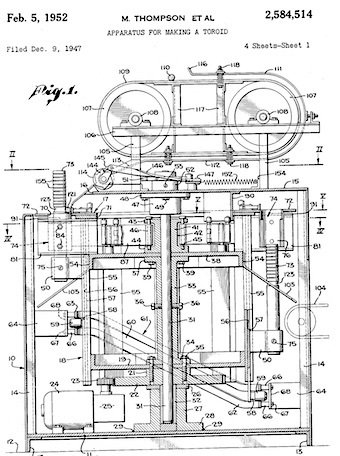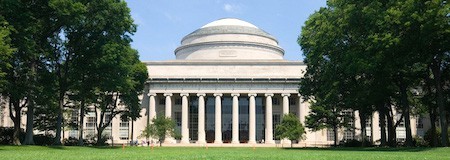Marc Abrahams's Blog, page 306
September 21, 2015
Farewell, bagel-making machine inventor
The New York Times brings sad news:
Daniel Thompson, Whose Bagel Machine Altered the American Diet, Dies at 94
Daniel Thompson, who five decades ago automated the arcane art of bagel making, a development — seen variously as saving grace and sacrilege — that has sent billions of mass-produced bagels raining down on the American heartland, died on Sept. 3 in Rancho Mirage, Calif. He was 94. His family announced the death last week.
A California math teacher turned inventor, Mr. Thompson was a shaper of postwar suburban culture in more than one respect: He also created the first wheeled, folding Ping-Pong table, a fixture of American basements from the mid-20th century onward.
But it was for the bagel machine that Mr. Thompson remained best known. The invention changed the American diet…
Mr. Thompson obtained several patents, over a long span of years, for devices and methods for making bagels. His earliest, U.S. patent #2584514, was granted in 1952, for an “apparatus for making a toroid“. Here’s some detail from the patent:
“Apparatus for making a toroid,” U.S. 2584514, granted to Meyer Thompson and Daniel Thompson, priority December 9, 1947.
“This invention relates to apparatus for form ing plastic, deformable, pliant, compositions such as dough into the shape of a toroid. Machines have heretofore been provided for forming dough. into the shape of a toroid, such as doughnut machines. However, the dough of certain products, such as that known as bagels, is of such a heavy, tough, elastic consistency that it can not be handled on doughnut machines and it has heretofore been necessary to form the bagel dough by hand. The dough is first rolled into cylindrical form and turned about the fingers of the operator to form a toroid with the ends overlapping. Then the overlapping ends are hand rolled into pressed, meshing, consolidated, integral relation, forming the toroid. This manner of manually forming the dough into a toroid is not only slow and in eficient, but due to the rolling of the overlapping ends, the result is an irregular deformed toroid. It is, therefore, the primary object of this invention to provide apparatus for forming dough into circular toroid shape.”

Surgical pathology and bird-watching – compare and contrast
 Chhanda Bewtra, M.D., M.B., B.S. who is Associate Professor of Pathology at Creighton University School of Medicine and Creighton University Medical Center, is also a birdwatcher.
Chhanda Bewtra, M.D., M.B., B.S. who is Associate Professor of Pathology at Creighton University School of Medicine and Creighton University Medical Center, is also a birdwatcher.
“I have been a diagnostic surgical pathologist for almost a quarter of a century. Recently, I took up bird-watching (or birding for short) as a hobby. Right away I was struck by the similarities in the two disciplines.”
The professor has compiled a nineteen-point ‘compare and contrast’ table which highlights the similarities of, and differences between: ‘Pathology and Birdwatching‘ (in American Journal of Dermatopathology: August 2003 – Volume 25 – Issue 4 – p 357 Letters to the Editor)
Here’s some detail from the study:

September 20, 2015
Japan-US diplomacy: Kissing
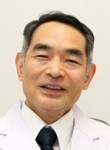 Kissing is among the subtle methods great nations use to fluff their relations. Here’s a fresh example — tweets in two languages by Caroline Kennedy, the American ambassador to Japan, saluting Dr. Hajime Kimata, who this week was awarded a 2015 Ig Nobel prize.
Kissing is among the subtle methods great nations use to fluff their relations. Here’s a fresh example — tweets in two languages by Caroline Kennedy, the American ambassador to Japan, saluting Dr. Hajime Kimata, who this week was awarded a 2015 Ig Nobel prize.
The tweets:
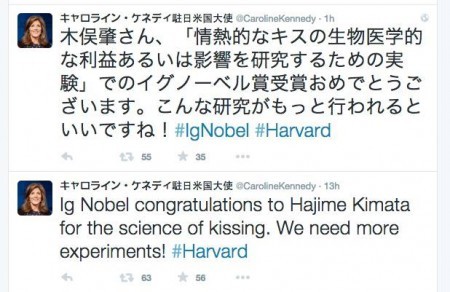
The prize:
The 2015 Ig Nobel Prize for medicine was awarded jointly to two groups: Hajime Kimata [JAPAN, CHINA]; and to Jaroslava Durdiaková [SLOVAKIA, US, UK], Peter Celec [SLOVAKIA, GERMANY], Natália Kamodyová, Tatiana Sedláčková, Gabriela Repiská, Barbara Sviežená, and Gabriel Minárik [SLOVAKIA], for experiments to study the biomedical benefits or biomedical consequences of intense kissing (and other intimate, interpersonal activities).
REFERENCES for the prize-winning achievements: “Kissing Reduces Allergic Skin Wheal Responses and Plasma Neurotrophin Levels,” Hajime Kimata, Physiology and Behavior, vol. 80, nos. 2-3, November 2003, pp. 395-8. / “Reduction of Allergic Skin Weal Responses by Sexual Intercourse in Allergic Patients,” Hajime Kimata, Sexual and Relationship Therapy, vol 19, no. 2, May 2004, pp. 151-4. / “Kissing Selectively Decreases Allergen-Specific IgE Production in Atopic Patients,” Hajime Kimata, Journal of Psychosomatic Research, vol. 60, 2006, pp. 545– 547. / “Prevalence and Persistence of Male DNA Identified in Mixed Saliva Samples After Intense Kissing,” Natália Kamodyová, Jaroslava Durdiaková, Peter Celec, Tatiana Sedláčková, Gabriela Repiská, Barbara Sviežená, and Gabriel Minárik, Forensic Science International Genetics, vol. 7, no. 1, January 2013, pp. 124–8.
Question: Will J. Liam Wasley, the American ambassador to Slovakia, tweet congratulations to the Slovakian co-winners of this prize?
RELATED: Australian government lauds Ig Nobel winner Colin Raston for throwing eggs at a problem:
Congrats Colin Raston @IgNobel prize winner finding new weapon in fight against cancer w support from @arc_gov_aubit.ly/1Ku0mHo
RELATED: Dutch government praises Ig Nobel winner Mark Dingemanse for… Huh?: “Bussemaker prijst ‘huh-wetenschappers’ “

The best engineered opening line ever written?
Are these not the finest opening words ever written for an engineering document — maybe for any work of literature?
Be it known that I, Luther C. Barcus, of the town of Sidney, county of Champaign, and State of Illinois, have invented certain new and useful Improvements in Monkey-Wrenches…
That’s the beginning of the patent (US number 753837) issued to Mr. Barcus on March 8, 1904. Here’s an image of the original patent document:
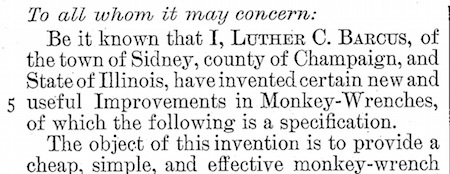
And here’s a drawing of Mr. Barcus’s monkey wrench:
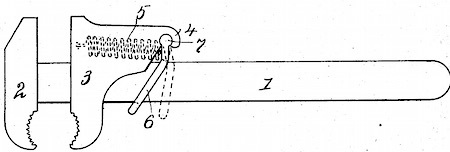

Creatures that present poo to their girlfriends as a gift
If you are in Johannesburg this week, you can hear details about the ways a male is judged by the size of his balls, if that male is a dung beetle.
It is not uncommon for male dung beetles to obtain sexual favors from females by presenting them with a ball of crap. But of course males cannot be entirely trusted and might pretend that they have deposited a big juicy piece of dung underground, only for the potential girlfriend to discover that this was a trick.
On 22 September 2015, in Johannesburg, South Africa Professor Marcus Byrne of the University of the Witwatersrand who is part of the team that won the 2013 Ig Nobel Prize for Biology and Astronomy for discovering that when dung beetles get lost they can navigate their way home by looking at the Milky Way, will give a talk titled “You can roll it, but I wouldn’t smoke it“.
BONUS. Prof Marcus Byrne is regarded as one of the sexiest scientists alive. In case you are unable to attend the evening of science and cocktails on the 22nd, you can read more about the shitty world of dung beetles here.

September 18, 2015
Saturday: The Ig Informal Lectures, at MIT
Saturday, Sep 19, 2015, 1:00 pm
MIT, building 10, room 250
A half-afternoon of improbably funny, informative, informal, brief public lectures and demonstrations:
The new, 2015 Ig Nobel Prize winners will attempt to explain what they did, and why they did it
Special appearance by past Ig Nobel Prize winners — including a special performance by Dr. Nakamats .
The Ig Nobel Prize winners will be available for you to talk with, both before and after the lectures
The Ig informal Lectures are a free event, organized in cooperation with the MIT Press Bookstore. But seating is limited, so we suggest you arrive a bit early.
(What happens at the Ig Informal Lectures? Here’s a spectator’s report from last year, 2013.)

September 17, 2015
Announcing the 2015 Ig Nobel Prize winners
The 2015 Ig Nobel Prizes were awarded to the winners tonight in a gala ceremony at Harvard’s Sanders Theatre, with a sold-out audience of 1100 in the theatre, and many more watching the live webcast.
The ten new winners and their achievements are now included in the list of all Ig Nobel Prize winners.
Here’s a photo of the Physics Prize acceptance speech being terminated at the persistent request of an eight-year-old girl (photo by Mike Benveniste / Improbable Research):
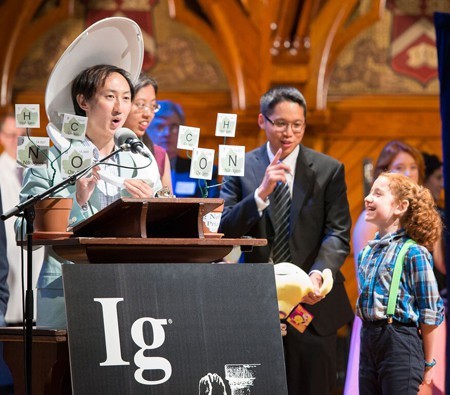
Here’s video of the Biology Prize-winning experiment:

September 16, 2015
Ig Nobel — Thursday night!
The Twenty-Fifth 1st Annual Ig Nobel Prize ceremony happens
Thursday, September 17, 2015, at 6:00 pm (US eastern time).
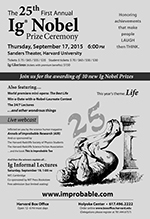 Watch the live webcast
.
Watch the live webcast
.And…
Simultaneously follow the action on Twitter:
We will be live-tweeting at @ImprobResearch
Lots of other people (maybe including you?) will be live tweeting at #IgNobel
Please spread the word!
Ps. Tickets to physically attend the ceremony are sold out. But… it’s possible that a very few tickets will become available in the last hours. If you’re willing to take a chance on that, check the Harvard Box Office web site, or, late in the afternoon, come to the ticket window at Harvard’s Sanders Theatre.
Download your own copy of IgBill, the printed program that is handed out to the audience members in Sanders Theatre. It contains a who’s who, and also the complete libretto to “The Best Life” — the new mini-opera that will be part of the ceremony:

Podcast 29: Eat a shrew, and an epidemic of penile amputations
The secret of why onions make people cry; the scientist who ate and excreted a shrew; the one-armed man who was arrested for applauding; the question of when cows lie down and stand up; and surgical management of an epidemic of penile amputations in Siam; and a cat unexpectedly taking over the podcast — all these all turn up in this week’s Improbable Research podcast.
Click on the “Venetian blinds” icon — at the lower right corner here — to select whichever week’s episode you want to hear:
SUBSCRIBE on Play.it, iTunes, or Spotify to get a new episode every week, free.
This week, Marc Abrahams tells about:
The 2013 Ig Nobel Prize winners – PART 2. (List of the 2013 Ig Nobel Prize winners, with links to their research. Featuring a dramatic reading by Jean Berko Gleason, whose cat, Foster, also entered into the doings . ) Here’s the study “Surgical Management of an Epidemic of Penile Amputations in Siam“:
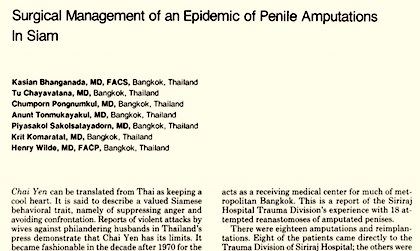
The 25th First Annual Ig Nobel Prize ceremony (and webcast), which will happen on Thursday, September 17, 2015.
The mysterious John Schedler perhaps did the sound engineering this week.
The Improbable Research podcast is all about research that makes people LAUGH, then THINK — real research, about anything and everything, from everywhere —research that may be good or bad, important or trivial, valuable or worthless. CBS distributes it, both on the new CBS Play.it web site, and on iTunes and Spotify).

Musical birds of a feather, when together, live ∼7.2 weeks less
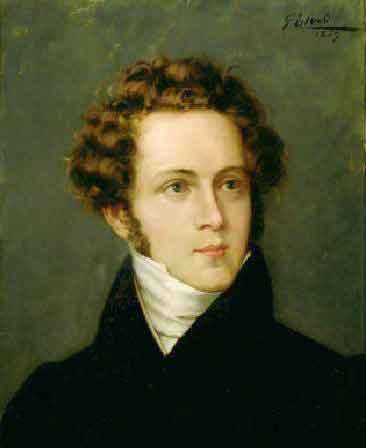 Artists of all kinds often tend to cluster together (think Montmartre etc.) bringing the benefits of collaboration, interaction and inspiration. But what if there are just too many? For composers, in Paris or Vienna for example, there could be competition for limited resources such as concert halls. In other words they might incur high stress levels, and accumulate ‘frenemies’, a situation which could, conceivably, in some cases, prove fatal. “[…] A one percent increase in the number of composers reduces composer longevity by ∼7.2 weeks.” – say authors professor Karol Jan Borowieckia (Department of Business and Economics, University of Southern Denmark) and Dr. Georgios Kavetsos (Department of Social Policy, London School of Economics) who have performed an in-depth analysis of just such a scenario, published in: Social Science & Medicine, Volume 134, June 2015, Pages 30–42. ‘In fatal pursuit of immortal fame: Peer competition and early mortality of music composers’
Artists of all kinds often tend to cluster together (think Montmartre etc.) bringing the benefits of collaboration, interaction and inspiration. But what if there are just too many? For composers, in Paris or Vienna for example, there could be competition for limited resources such as concert halls. In other words they might incur high stress levels, and accumulate ‘frenemies’, a situation which could, conceivably, in some cases, prove fatal. “[…] A one percent increase in the number of composers reduces composer longevity by ∼7.2 weeks.” – say authors professor Karol Jan Borowieckia (Department of Business and Economics, University of Southern Denmark) and Dr. Georgios Kavetsos (Department of Social Policy, London School of Economics) who have performed an in-depth analysis of just such a scenario, published in: Social Science & Medicine, Volume 134, June 2015, Pages 30–42. ‘In fatal pursuit of immortal fame: Peer competition and early mortality of music composers’
“We extract data for 144 music composers born in the 19th century and calculate four measures that approximate peer competition: (1) the average number of peers residing in the same location and time; (2) the lifetime average share of peers located in the same location and time; (3) the share of a composer’s life spent in one of the main locations for music, where peer group size – and thus competition – is potentially at its highest; and (4) the quality of fellow composers (calculated as the sum of quality indices of all composers located in the same location and time).“
Based on the findings :
“One could calculate the longevity loss as a result of a one percentage increase in the number of composers located in the city; this would imply a sensible, yet non-negligible shorter duration of life by 10 weeks.”
Their paper may be found in its entirety here.
Note: The picture shows composer Vincenzo Salvatore Carmelo Francesco Bellini who spent time in both Paris and Vienna, and who died at the early age of just 34.

Marc Abrahams's Blog
- Marc Abrahams's profile
- 14 followers


